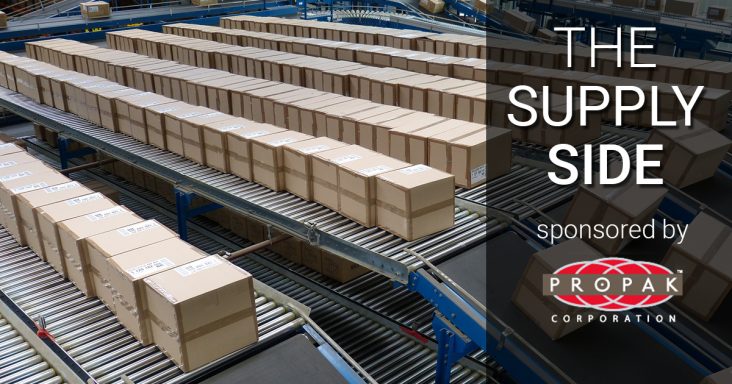The Supply Side: Retailers retooling for post-pandemic success
by December 18, 2021 10:00 am 1,609 views

A recent 38-page report by consulting firm McKinsey & Co. compiled with Retail Industry Leaders Alliance (RILA) outlined imperatives for rethinking retail.
The researchers surveyed 30 retailers to gain insights on more than 100 metrics, from consumer outlook to the future supply chain. They interviewed top executives with Walgreens, Dollar General, Target, Ulta Beauty, Nordstrom, Ikea and The Home Depot for the research.
One common theme in the report was the acceleration of online sales that industry insiders believe jumped at least three years ahead during 2020. Many major retailers invested heavily in omnichannel capabilities like in-store or curbside pickup for online orders in recent years. They expanded delivery services in as little as two hours in some cases. Drones and self-driving cars are also being used in numerous tests.
For all retailers, the future arrived in March 2020 as COVID-19 forced consumers to change their buying behaviors. Buy online, pick up in-store (BOPIS) has surged 40% since the start of the pandemic. As 75% of consumers tried new shopping methods, that pushed e-commerce sales volumes as high in the first quarter of 2020 as in the previous 10 years combined, McKinsey noted.
The report delved into what comes next and examined the strategies necessary for future success. The recommendations are broken down into two main segments: doubling down on consumer-driven commerce and investing for growth.
Retailers first agree they must become omnipotent with omnichannel because consumers choose to shop based on the ease of the end-to-end experience. McKinsey reported that 65% of survey respondents cited omnichannel growth as the most significant trend impacting the industry and its biggest challenge. McKinsey projects e-commerce will range between 25% and 40% of sales across multiple categories after the pandemic. Categories such as sports, leisure and home improvement are expected to see online sales double.
 While Walmart and Target were early investors in omnichannel capabilities, the dollar store segment was not.
While Walmart and Target were early investors in omnichannel capabilities, the dollar store segment was not.
“For us, some e-commerce priorities that were previously five years out are now more of a three-year horizon. We need to more quickly understand how to satisfy that consumer and accelerate our timelines accordingly,” Dollar General CEO Todd Vasos stated in the report.
Retailers must continue to upgrade e-commerce capabilities by developing inventory plans based on real-time digital and physical trends, not just historical performance. They must also provide consumers with more transparency regarding inventory availability, according to McKinsey.
Nordstrom said it has linked its digital and physical product offerings in its top 10 markets. That allowed it to offer four times the selection available for next-day delivery and expand BOPIS locations to include 249 Nordstrom Rack locations in addition to all 100 Nordstrom stores.
Walmart also married its online and in-store merchant divisions and consolidated two consumer apps into one. The retail giant also continues to use most of its stores as fulfillment centers for thousands of items besides grocery.
Amid the pandemic, 44% of stores served partially or entirely as fulfillment centers for online sales. The report states that by next year, retailer respondents expect that number to increase to 57% as more stores will focus on BOPIS and ship-from-store services.
“Both experiences and fulfillment are important uses for brick and mortar stores. We will continue to evolve the role of the store in this omnichannel strategy evolution,” said Ulta Beauty CEO Mary Dillon.
With more sales moving online, retailers must continue to invest and expand delivery options. While ongoing supply chain disruptions have disrupted even the most efficient delivery services, retailers said they expect dramatic changes in consumers’ expectations for delivery over the next three years. More than 90% of consumers see two to three days as a baseline, and 30% expect same-day delivery. The targets vary by category, with groceries expected the same day. Retail executives said they continue to invest in faster deliveries. Walmart and Albertsons are investing in micro-fulfillment capacity to offer faster deliveries and reduce logistics costs.
Target acquired Shipt in 2017 and built a network of personal shoppers who pick up goods at Target or other retailers and deliver them to a consumer’s home within two hours.
McKinsey stated that retailers that fail to upgrade their fulfillment model run the real risk of their supply chain adversely affecting profitability. The report found that 80% of retailers plan to concentrate their 2022 supply chain spending on improving e-commerce fulfillment. Other areas where retailers must rethink their processes and agendas include personalization across various shopping methods and where they stand on social justice, environmental and sustainability.
There is growing evidence that consumers are aligning their purchasing power with businesses’ societal commitments. McKinsey found that 33% stopped using a brand because of social actions in 2020, and 71% said they would lose trust in a brand forever if it places profits over people. And 57% of consumers believe companies need to redefine their purpose to fight the pandemic.
Retailers seeking success must also recalibrate talent strategies to win the war for diverse talent in a tight labor pool. Growing ecosystems around their core businesses is another way retailers are looking to position themselves for future success.
Walmart has grown its ecosystem in recent years following the lead from Amazon. Brett Biggs, chief financial officer at Walmart, has said an ecosystem approach gives the retailer more levers to pull to offset rising prices and tighter gross margins. Using the ecosystem approach also helps diversify income. Walmart has invested in health services in many markets where it sees gaps in primary care for underinsured and insured consumers. Walmart also offers technology repair services in select stores, a business akin to Best Buy’s Geek Squad. The company launched a membership program dubbed Walmart+ that generates membership revenue in exchange for perks like fuel savings at select stations and free prescriptions for some commonly prescribed drugs. Walmart also runs a marketplace that generates additional revenue.
McKinsey’s analysis suggests ecosystems across a dozen sectors will collectively function as a $60 trillion economy by 2025. For retailers looking to grow their ecosystems, the report recommends exploring nontraditional retail partnerships by joining forces, something Walmart and Target are doing.
Finally, investments in productivity from enabling analytics, automation, boosting private-brand innovation, and better sourcing round out the retailer recommendations.
Editor’s note: The Supply Side section of Talk Business & Politics focuses on the companies, organizations, issues and individuals engaged in providing products and services to retailers. The Supply Side is managed by Talk Business & Politics and sponsored by Propak Logistics.
